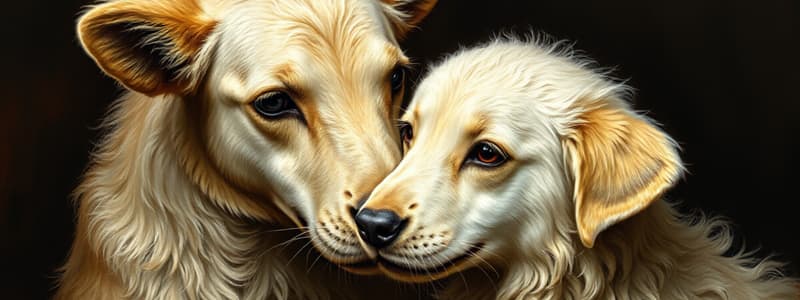Podcast
Questions and Answers
What term is used to define multicellular eukaryotic organisms in a scientific context?
What term is used to define multicellular eukaryotic organisms in a scientific context?
- Fungi
- Plant
- Animal (correct)
- Mineral
How do psychological factors influence human-animal relationships?
How do psychological factors influence human-animal relationships?
- They create arbitrary categories leading to selective care for certain animals. (correct)
- They have no significant impact on interactions with animals.
- They ensure all animals are treated equally regardless of species.
- They eliminate all emotional connections between humans and animals.
Which of the following interactions with animals is considered indirect?
Which of the following interactions with animals is considered indirect?
- Feeding a pet
- Hiking in a national park
- Using leather products (correct)
- Observing wildlife in a reserve
What is a notable fact about the estimated number of animal species on Earth?
What is a notable fact about the estimated number of animal species on Earth?
What role do animals play in environmental services that humans benefit from?
What role do animals play in environmental services that humans benefit from?
What is a common reason people keep pets despite the inconveniences they present?
What is a common reason people keep pets despite the inconveniences they present?
How might societal perceptions of animals impact conservation efforts?
How might societal perceptions of animals impact conservation efforts?
What term describes more highly regarded animals that receive more attention and care in human interactions?
What term describes more highly regarded animals that receive more attention and care in human interactions?
How does cultural context influence human relationships with animals?
How does cultural context influence human relationships with animals?
What is the concept introduced by Carl Sagan that provides perspective on human history?
What is the concept introduced by Carl Sagan that provides perspective on human history?
What has been a common attitude towards wolves in different cultures?
What has been a common attitude towards wolves in different cultures?
What role does a changing cultural perspective play in animal conservation efforts?
What role does a changing cultural perspective play in animal conservation efforts?
What do scientists mean by the term 'relative recentness' in the context of human-animal relationships?
What do scientists mean by the term 'relative recentness' in the context of human-animal relationships?
Which statement best reflects the significance of understanding historical perspectives in human-animal relationships?
Which statement best reflects the significance of understanding historical perspectives in human-animal relationships?
What commonality exists among species like rats, dolphins, and dingos regarding human perceptions?
What commonality exists among species like rats, dolphins, and dingos regarding human perceptions?
In what way does the study of human-animal relationships encourage critical thinking?
In what way does the study of human-animal relationships encourage critical thinking?
What dynamic is illustrated through the case study of wolves within different cultural contexts?
What dynamic is illustrated through the case study of wolves within different cultural contexts?
Which of the following statements about the significance of 'time' and 'space' in understanding animals is true?
Which of the following statements about the significance of 'time' and 'space' in understanding animals is true?
Flashcards are hidden until you start studying
Study Notes
Interacting with Animals
- Animals are crucial for companionship, food products, and environmental balance.
- Definition of 'animal' varies: scientifically, it refers to multicellular eukaryotes; colloquially, it often means non-human creatures.
- Human perceptions of animals shape relationships and interactions, categorized into pets, wildlife, and livestock.
- Indirect interactions with animals include using products like leather and meat, and relying on services such as pollination.
- Emotional factors affect perceptions: charismatic species receive more attention than lesser-known invertebrates.
- There could be between 5 and 100 million animal species globally, with only about 2 million identified, mainly insects.
- Invertebrates represent a greater organic mass in forests compared to larger vertebrates.
- Discussion prompts explore cultural differences in animal consumption, societal impacts on conservation, and motivations for pet ownership.
Time, Place, Culture, and Our Understanding of Animals
- Human-animal relationships vary by cultural and temporal contexts, influenced by perceptions of time and space.
- Both humans and current animal species are relatively recent on Earth, reflecting the novelty of modern interactions.
- Cultural influences dictate how animals are perceived: pets are valued in the West, while cows are revered in cultures like Hinduism.
- The wolf exemplifies dynamic relationships: once persecuted, now respected in certain cultures, illustrating changing perceptions over time.
- Carl Sagan crucially linked human existence to the cosmic scale, highlighting Earth as a "pale blue dot" in the universe.
- Understanding our cosmic context emphasizes the importance of our actions on other species and ecosystems.
- Cross-cultural differences in animal relationships are stark; for instance, cows in Australia vs. India, and varied perceptions of wolves in North America.
- Encourages critical thinking about individual views and practices regarding animals through historical and cultural lenses.
- Future discussions can include perceptions of other species like rats and dolphins, and their influence on conservation efforts.
Studying That Suits You
Use AI to generate personalized quizzes and flashcards to suit your learning preferences.



